Uber riders in Pittsburgh get a taste of driverless future
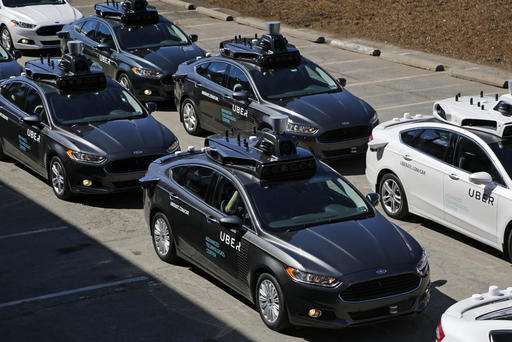
Taylor Pollier got an offer from Uber he couldn't refuse—to be part of an experiment with a car of the future.
Uber on Wednesday became the first company to make self-driving cars available to the general public in the U.S. through a test program in Pittsburgh. The ride-hailing service selected a group of customers, including Pollier, to take free rides in autonomous Ford Fusions, with human drivers as backups.
Pollier, 27, said the Fusion "felt sharp," and the 15-minute ride to his bartending job went smoothly and felt "like taking an Uber any other day."
If other riders have a similar reaction, and the autonomous cars are able to handle all the challenges Pittsburgh offers, including snowstorms, rolling hills and a tangled network of aging roads and bridges, then the self-driving car will be one step closer to going from science fiction to a realistic option for travelers.
"That pilot really pushes the ball forward for us," said Raffi Krikorian, Director of Uber Advanced Technologies Center (ATC) in Pittsburgh, the company's main facility for testing self-driving vehicles. "We think it can help with congestion. We think it can make transportation cheaper and more accessible for the vast majority of people."
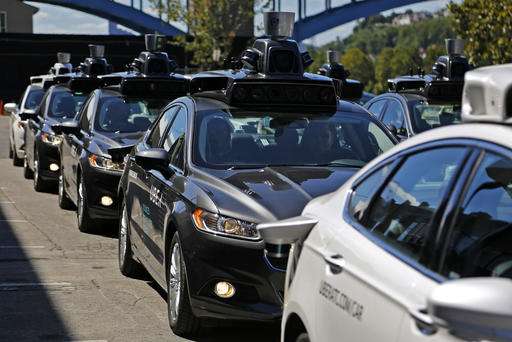
The race between Silicon Valley upstarts and traditional automakers to perfect a fully driverless car to serve regular people has intensified. Companies such as Audi, Nissan and Google have invested hundreds of millions of dollars and logged millions of miles test-driving autonomous vehicles, typically in more ideal locations such as California. Ford recently announced plans for a fully driverless car for use in ride-hailing and car-sharing programs by 2021.
The developments are ahead of regulations in some states. This spring, Uber employees first took the self-driving cars to and from work every day - perfectly legal under current state law, Pennsylvania officials said.
"There's no requirement that you be touching the steering wheel," said Kurt J. Myers, deputy secretary at the Pennsylvania Department of Transportation. "But there is a requirement that you are a licensed driver and that you are in the driver's seat."
Approaches to driverless technology differ. Google, a unit of Alphabet, and Ford say the only safe option for riders is a fully driverless car—no steering wheel, no pedals and no human operator. Others, like Mercedes-Benz, are adding autonomous features in phases, while relying on the driver to take over in certain circumstances.
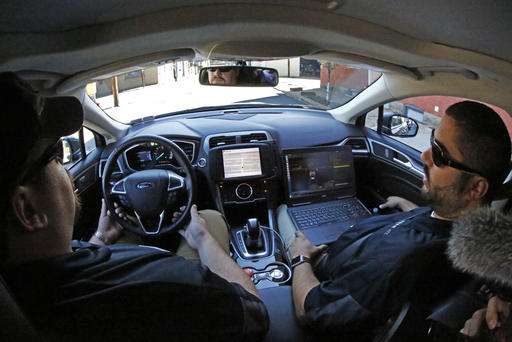
Many experts predict that it will be years, if not decades, before the public is being driven around in fleets of fully driverless vehicles under any condition. Some are apprehensive about involving humans as passengers while removing them as drivers before the technology has been thoroughly tested.
"Because vehicles are driving at seventy miles per hour on the highway, if something goes wrong, things could go wrong very bad, very quickly," said Carnegie Mellon engineering Professor Raj Rajkumar. "This technology needs to be ultra-reliable before we can take the human out of the driving equation."
NuTonomy, a spinoff from the Massachusetts Institute of Technology, got the jump on Uber globally three weeks ago when it began picking up passengers in self-driving taxis in a district in Singapore. The company said Tuesday that its six taxis—with backup drivers—haven't had any accidents since the service launched.
The Uber vehicles are equipped with everything from seven traffic-light detecting cameras to a radar system that detects different weather conditions to 20 spinning lasers that generate a continuous, 360-degree 3-D map of the surrounding environment. During the test program, two engineers are seated in front—a backup driver and another monitoring the car's 3D map and scribbling notes on how to improve the car's software.
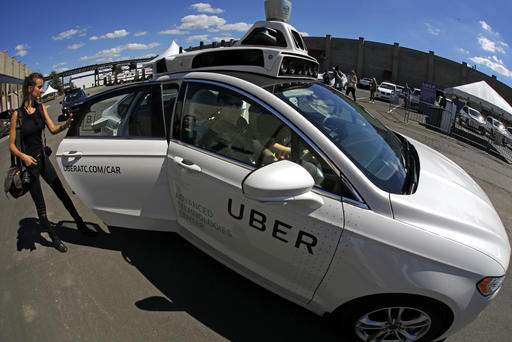
Uber executives are watching to see how the cars handle Pittsburgh's notoriously tricky driving conditions to determine when fully driverless vehicles will be ready to hit the roads.
"We actually think of Pittsburgh as the double black diamond of driving," Krikorian said. "If we can really tackle Pittsburgh, that we have a better chance of tackling most other cities around the world."
Besides road conditions, Uber must also tackle people's fears about self-driving technology.
"It scares me not to have a driver there with an Uber," said Claudia Tyler, a health executive standing near the entrance of an office in downtown Pittsburgh.
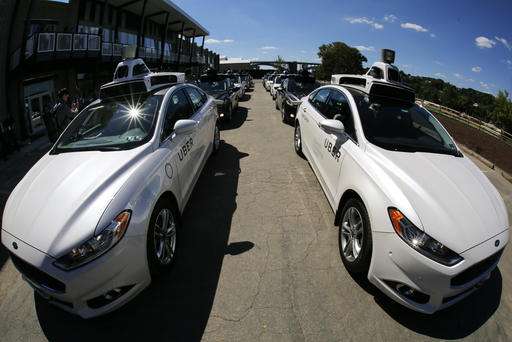
When the drivers are removed from front seats, the cars will likely be restricted to driving in specific locations under good conditions at first.
A study released Wednesday by the University of Michigan found that 23 percent of Americans wouldn't ride in a self-driving car. Uber officials hope the initial trial will teach them how to ease public fears of adopting the leading-edge technology.
"The Pittsburgh pilot is our opportunity for real world testing, so that we can learn more about what makes riders feel safe and comfortable," said Uber product manager Emily Bartel.
Uber's Silicon Valley roots mean it tends to pivot quickly and plan, experiment, and adjust direction within weeks, in contrast to longtime carmakers like General Motors or Toyota who have years-long timelines when bringing out new features, Rajkumar and Uber officials said.
"I'd probably give them a little bit and let them work their kinks out," Patrick Holland, a Philadelphia-area student, said right before getting into a human-driven Uber. "But I think a product that's well-tested and it's proven to work and safe—I think that's where we're heading, and I think I'll eventually find myself in a driverless vehicle."
-
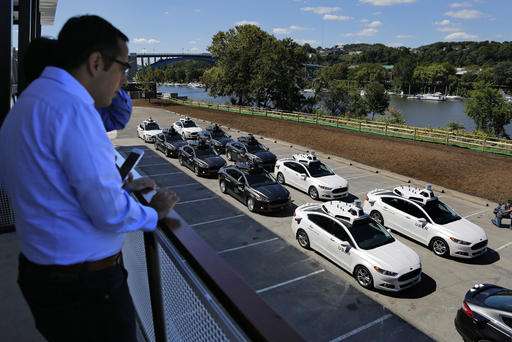
A group of self driving Uber vehicles position themselves to take journalists on rides during a media preview at Uber's Advanced Technologies Center in Pittsburgh, Monday, Sept. 12, 2016. Starting Wednesday morning, Sept. 14, 2016 dozens of self-driving Ford Fusions will pick up riders who opted into a test program with Uber. While the vehicles are loaded with features that allow them to navigate on their own, an Uber engineer will sit in the driver's seat and seize control if things go awry. (AP Photo/Gene J. Puskar) -
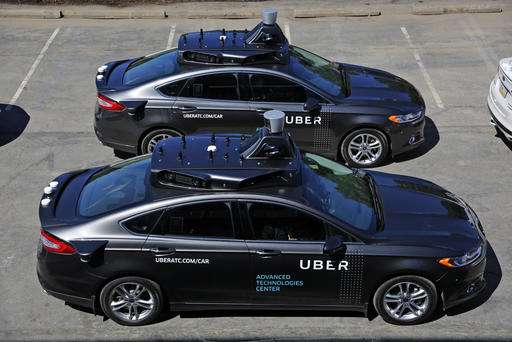
A group of self driving Uber vehicles position themselves to take journalists on rides during a media preview at Uber's Advanced Technologies Center in Pittsburgh, Monday, Sept. 12, 2016. Starting Wednesday morning, Sept. 14, 2016 dozens of self-driving Ford Fusions will pick up riders who opted into a test program with Uber. While the vehicles are loaded with features that allow them to navigate on their own, an Uber engineer will sit in the driver's seat and seize control if things go awry. (AP Photo/Gene J. Puskar) -
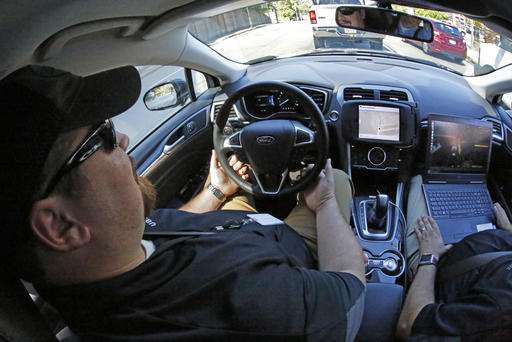
Uber safety driver Zachary Rearick takes journalists on a drive through the streets of downtown Pittsburgh in a self driving Uber, Monday, Sept. 12, 2016. Starting Wednesday morning, Sept. 14, 2016 dozens of self-driving Ford Fusions will pick up riders who opted into a test program with Uber. While the vehicles are loaded with features that allow them to navigate on their own, an Uber engineer will sit in the driver's seat and seize control if things go awry. (AP Photo/Gene J. Puskar) -
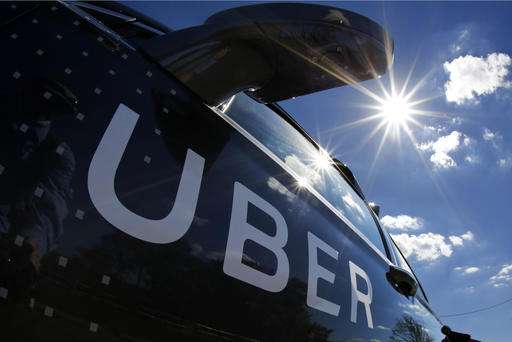
A self driving Uber sits ready to take journalists for a ride during a media preview in Pittsburgh, Monday, Sept. 12, 2016. Starting Wednesday morning, Sept. 14, 2016 dozens of self-driving Ford Fusions will pick up riders who opted into a test program with Uber. While the vehicles are loaded with features that allow them to navigate on their own, an Uber engineer will sit in the driver's seat and seize control if things go awry. (AP Photo/Gene J. Puskar)
© 2016 The Associated Press. All rights reserved.





















